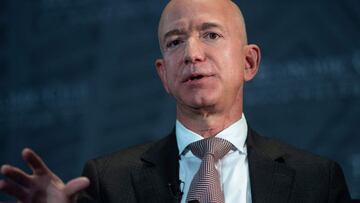Jeff Bezos’s economic prediction: “You have to batten down the hatches”
Inflation and rising interest rates could cause a recession and former Amazon CEO is chiming in with his predictions.

The energy crisis and inflation are spreading more and more. The latest to speak about these tough times for the economy has been the founder of Amazon, Jeff Bezos, who has warned that even more difficult times are ahead.
Bezos published a tweet last Tuesday night in which he commented on the economic assessments that the CEO of Goldman Sachs, David Solomon, made to the CNBC network.
“I think it’s time to be cautious, and I think if you have a risk based business [...] it’s time to think more carefully about your risk box,” said Solomon.
Looking at the future scenarios, the Goldman Sachs CEO also said that one should “expect more volatility on the horizon” and that in the “distribution of results, there’s a high possibility that we’ll have a recession in the United States.”
Bezos tweeted that he agreed with Soloman and that to him economic indicators show that it may be time to “batten down the hatches,” in terms of risk mitigation. This turn of phrase comes from the yachting world and means that if times are tough you have to take few risks and be cautious.
Recession in the United States?
Solomon is not the only big businessman who has warned about the risks of the energy crisis. JPMorgan Chase CEO Jamie Dimon has also been warning of trouble ahead. He assured that the situation is “very serious” and that there is also a possibility that the US enters a recession in the next six months.
On the other hand, the executive director of Bank of America, Brian Moynihan, explained to CNBC that the data they receive from their clients’ credit cards shows that consumer spending is maintained despite inflation. “In the current environment, the consumer is pretty good and strong,” he said.
This may be true but this creates an additional risk for the economy. Consumer demand will reach its limits if prices continue to rise. If supply cannot be increased, firms could see a decrease in revenue if they push up prices to limits that are inaccessible to consumers.
What is driving the risk of recession?
Golden Sachs released a report in August detailing the factors that are increasing the chance of a recession and how intense they would expect the impact to be.
One of the causes for the financial giant is “unusually high level of job openings [which] dampens the employment effects of a negative output shock.” Currently there are almost two jobs for every one person looking. Trading Markets has reported that in September firms announced that second largest number of layoffs this year. So even has a tight labor market drives up process, firms are continuing to cut workers from the payroll - creating even more pressure. However, layoffs could bring prices down, and Golden Sachs agrees, estimating the if a recession does occur, the economy is likely to see a “slight” increase in unemployment. Those who find themselves without work will see a decrease in their purchasing power which can lower effective demand across the economy, if enough people are thrown from the labor force.
Federal Reserve Chairmen Jerome Powell agrees and has acknowledged that central bank’s move to increase interest rates will “bring some pain to households and businesses,” he sees them as “unfortunate costs of reducing inflation,” and that “a failure to restore price stability would mean far greater pain.”
Increasing interest rates is one of the main tools at the disposal of the Fed to “bring demand and supply into better balance.” However, this is really a demand side measure as interest rates impact consumer and business willingness to borrow. This approach to lower inflation will lead to “slower growth, and softer labor market conditions” with Chairmen Powell acknowledges that these conditions “will also bring some pain to households and businesses.” A softer labor market implies that workers will face greater pressure to rejoin the labor force and give them less power to negotiate salaries in benefits.
Chairmen Powell has blamed inflation, in part, on the strength of the labor market, which the Fed sees as “clearly out of balance, with demand for workers substantially exceeding the supply of available workers.” Since the central bank began increasing interest rates in the spring, the number of open jobs has fallen from 11,681 to 10,053. By increasing interest rates, firms may decide not to hire a person to fill the role, which will further limit the number of openings. Real wages have decreased on average three percent since September 2021, showing that the power of workers may be a bit overstated.
The Federal Open Market Committee’s (FOMC) overarching focus right now is to bring inflation back down to our 2 percent goal. Price stability is the responsibility of the Federal Reserve and serves as the bedrock of our economy. Without price stability, the economy does not work for anyone. In particular, without price stability, we will not achieve a sustained period of strong labor market conditions that benefit all. The burdens of high inflation fall heaviest on those who are least able to bear them.
Restoring price stability will take some time and requires using our tools forcefully to bring demand and supply into better balance. Reducing inflation is likely to require a sustained period of below-trend growth. Moreover, there will very likely be some softening of labor market conditions. While higher interest rates, slower growth, and softer labor market conditions will bring down inflation, they will also bring some pain to households and businesses. These are the unfortunate costs of reducing inflation. But a failure to restore price stability would mean far greater pain.






